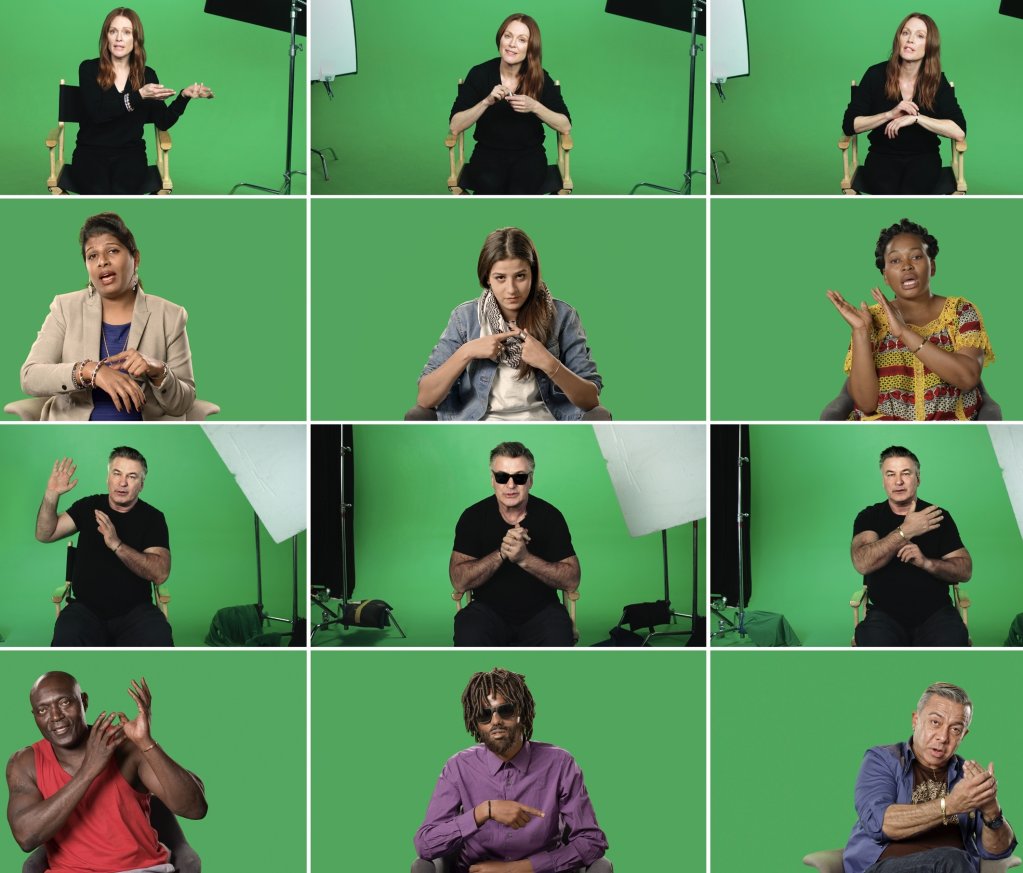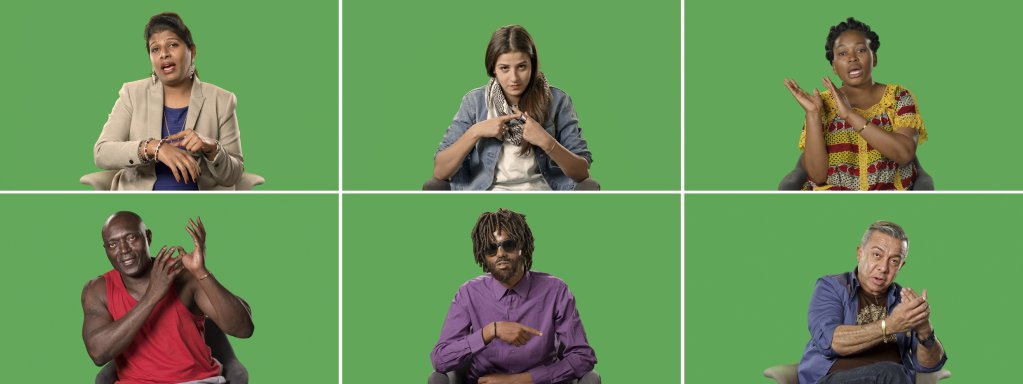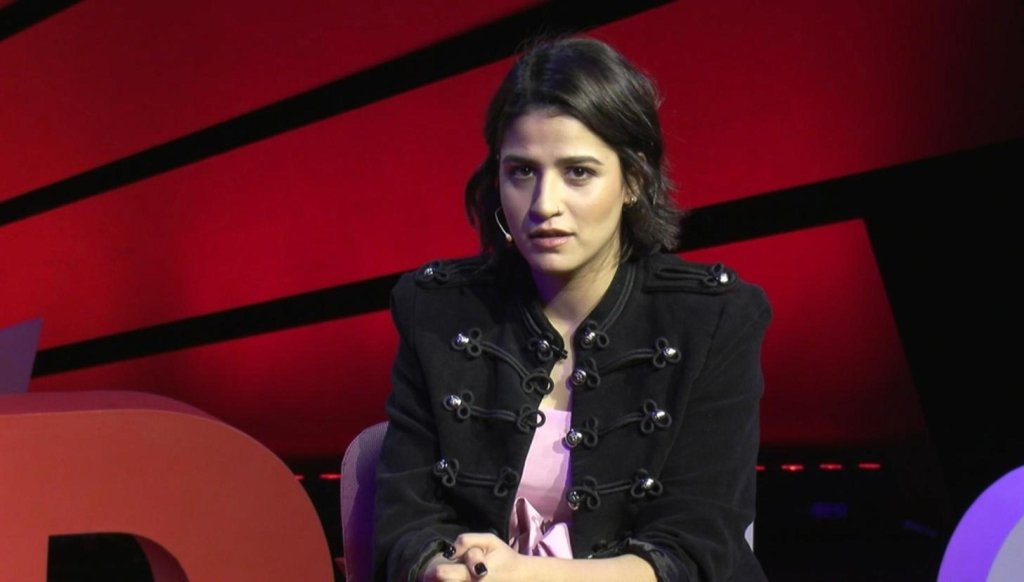
Who will you listen to? Refugees or Hollywood actors
The Tate gallery in Liverpool, UK has just opened an exhibition of a 2016 video installation by the artist Candice Breitz. In it, she looks at the global nature of refugee’s stories, and asks: In our media-saturated world, are we more likely to listen to a Hollywood actor recounting a refugee story, or the unknown refugee themselves?
“My name is Farah Abdi Mohammed, I am 27-years-old. I left Somalia in 2012.” So begins Mohammed’s story in the South African, Berlin-based artist Candice Breitz’ Love Story, 2016.
All the participants in the project have stories of flight. Participants include Syrian refugee Sarah Ezzat Mardini, former child soldier José Maria Joao from Angola, Mamy Maloba Langa who fled sexual violence in the Democratic Republic of Congo (DRC), Indian transgender activist Shabeena Francis Saveri, and Luis Ernesto Nava Molero, a political dissident from Venezuela.
“When the war started,” explains Mardini, who was interviewed in 2015, aged just 20, “we were shocked. We were watching war in Libya, in Egypt, but we never believed something like that would happen in Syria. It is so bad for us because we lost a lot.”
Mohammed now lives in Germany, as does Sarah Ezzat Mardini. The other participants are split between New York and Cape Town in South Africa.
‘Do you swear to us you are a refugee?’
Mardini remembers when she first arrived in Germany, people would say to her: “‘Do you swear to us you are a refugee? Are you sure? You wear Nike, you have a phone, you wear jewelry.’ So I would stop and say to them: ‘Why do you think all the refugees don’t have money?'”
In Mohammed’s story, he tells of how, after leaving Somalia, he went to Egypt where he stayed for a couple of years. He then moved on to Alexandria and then Port Said where he took a boat out into the Mediterranean.
Once at sea, Mohammed says he was picked up by the Italian navy and taken to Italy. He stayed, he says, for ten days in Italy, in the capital Rome, before moving on to southern Germany and Munich and finally to the German capital Berlin.
“It is very difficult to explain the situation in Somalia right now,” says Mohammed to the camera. “In some parts of Somalia there is a war, in others there is no central government on which the people can rely.”

‘What kinds of stories are we willing to hear?’
Each participant sits on a black director’s chair against a green screen. But this is not simply films of refugee stories. In the first room of the exhibition at Tate Liverpool, these same stories are re-told in snippets by the Hollywood actors Julianne Moore and Alec Baldwin.
They too sit against a green screen in a chair, and speak the words of the refugees. In the press materials accompanying her exhibition, Breitz asks us to consider, “What kinds of stories are we willing to hear? What kinds of stories move us?”
The artist said she wanted to “interrogate the mechanics of identification and the conditions under which empathy is produced.” The basis of her work are the stories of people who took flight before or during the height of the so-called refugee crisis in 2015, all were forced to flee the countries of their births “because of a range of oppressive conditions.”
Love Story, explains the press release “reflects on the callousness of a media-saturated culture in which identification with fictional characters and celebrity figures runs parallel to widespread indifference to the plight of those facing real world adversity.”
The work has already been shown in the South African Pavillion at the Venice Biennale in 2017, and now is being showcased for the first time in the UK after it was acquired for the Tate’s collection.
‘Even more relevant now than it was back then’
Tate Liverpool’s Director Helen Legg, told the BBC Today Programme on Thursday (July 21) that the exhibition had been commissioned a while back but delayed because of COVID. However, she said that now, the stories contained within, although they had been recorded in 2016 “felt even more relevant now than it did back then” when they had planned to put on the show prior to the pandemic. Perhaps, that is because, since then the numbers of migrants, refugees and displaced people in the world has continued to rise.
In fact, in June this year, the UN Refugee Agency UNHCR said that numbers of displaced people had continued to rise for the last decade. By May 22, more than 100 million people were forcibly displaced worldwide, either due to persecution, conflict, violence, human rights violations or events seriously disturbing public order.
Legg explains to the BBC that the creator of the exhibition, artist Candice Breitz, said that her project began when more than one million asylum seekers and refugees arrived in Germany during the course of 2015 and 2016. She felt that as an artist, something she could do was record their stories. Then one of her interviewees asked her: “Why are you doing this? Why are you telling our stories? No one is interested in us, no one will listen, you need a Hollywood star.”
So Breitz, explains Legg, decided to ring Alex Baldwin who she had worked with some years previously. He said “Who will be my counterpart?” and Breitz knew he had recently worked with the actor Julianne Moore, and suggested her and the project was born.

‘I cannot speak for all refugees…’
“I cannot speak for all refugees, but I believe many refugees, including me, would like to live in their own countries, if they could just live there in peace and freedom,” explains Mohammed. They want to be able “to choose whatever they like, freedom of speech and freedom of religion,” the atheist explains.
“In Somalia,” says Mohammed “there is no system…that protects the rights of people. So, it is very difficult to say there is freedom of speech or freedom of religion in Somalia.”
Mohammed recounts how when his father was killed, his mother was pregnant with him. “He was killed by another tribe. So he was killed only because he wasn’t in their tribes,” says Mohammed. He says as a child, although some of his wider family were “quite rich,” his immediate family weren’t and his mother brought him and his sister up alone. “I used to hallucinate food coming to us,” he says quietly, remembering the hunger they often endured.
‘My journey takes 25 days, from when I left Damascus to when I get to Berlin’
Sarah Ezzat Mardini has similarly strong family ties. “I left Damascus on August 12, 2015 on an airplane, me and my sister [Yusra Mardini] together. My journey takes 25 days from when I left Damascus to when I get to Berlin.”
Mardini and her sister became famous on their journey, both competitive swimmers in Syria, they helped swim the boat they traveled in from Turkey to Greece to safety when it got into trouble. She remembers how scared she and her sister were when they decided to get into the boat. Even though they were strong swimmers, “you don’t know what will happen, your head could hit a rock,” she explains.
Eventually it was their turn, they were woken up in the middle of the night by the smugglers and rushed down to the beach, men shouting at them. She and her sister were two of very few women on the boat that night. “It was an inflatable dinghy for about eight people, but they put 20 in it,” Mardini remembers with a wry smile. “I was so scared, I felt something was wrong, but I could do nothing. I didn’t believe I would get [over to the other side]. When we were in the boat, everyone was praying so loud. The voice of 20 person become one voice, everyone was saying ‘oh god help us.’ The small baby kept smiling for us, he wasn’t scared.”

‘I was thinking I am a swimmer, I cannot sit here and cry’
After 15 minutes the motor stopped, the boat was so heavy it began sinking, remembers Mardini. One guy went into the water and tried to help. Mardini says she felt responsible for everyone’s lives. “I was thinking, I am a swimmer, I shouldn’t just sit there like a small baby, crying, I must do something to help other people. I stood up, I look at the water. I feel like it was the first time of my life I jump into water. I said before I go in the water, if I die for this 20 people but shame on me that I am swimmer so if I let anyone die I will never forgive myself.”
Her sister joined her, “it was the scariest moment of my life.” Mardini said she caught the rope on the side of the boat and she started pumping her legs. Her sister did that too. Four of them propelled the boat forwards. But the water got colder and colder and Mardini remembers she couldn’t move her legs. But her training as a lifeguard kicked in. They were in the water for 3.5 hours but it felt more like “10 hours or 24 hours,” remembers Mardini, “It was a nightmare, I can’t go in the sea now.”
In 2015, Mardini was 20, that means a large part of her teenage years was lived during the war in Damascus, Syria. “You have to forget about everything,” she explains, listing the internet, going out with friends, phones, study and electricity as just some of the things they were forced to do without.
‘We only need our future’
Mardini explains that she was forced to leave Syria in “the illegal way” because “if you want to get a visa, you must wait six or seven years, so it is better and faster to leave Syria the illegal way.”
“Because we are refugees, some people think we don’t study, we need their old clothes, we need food and we need money. I have only one word for them, we are not refugees for money. We are refugees from war. We don’t need your money, we only need our future. Everyone is waiting for their papers. When we get our papers, we will go and get work and get money from this. No one who comes to Europe has this [thought] please give me money. Everyone is here to work and to find their own future.”
“When I got to Germany, I cried,” says Mardini simply. “When I got here, I said only one word, I feel like I am human again. As a refugee I don’t want anyone to feel pity for me, or feel sorry for me. I don’t want anyone to help me, I can find my way in this life.”
